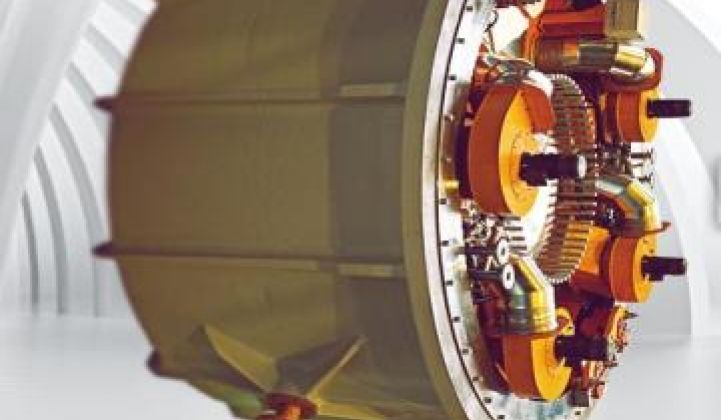Eric Lane, the patent expert at Luce, Forward, sent along this piece from his Green Patent Blog written by Philip Totaro about the future of wind.
We at Totaro & Associates have published a new study of the U.S. patent landscape of wind turbines to determine which technological trends have emerged so far and what we might be able to infer for the future direction of wind turbine technology.
Our study focused on the most prevalent sector of wind turbine technology -- utility-grade, horizontal-axis wind turbines.
The methodology involved searching and aggregating relevant results using technology keyword classification, then analyzing those results to identify the degree of relevancy to the industry for each patent. We found and analyzed over 1450 patents just for the U.S.
I. Today’s Wind Patents: (Mostly) Yesterday’s Solutions
Most of today’s wind patents solve yesterday’s problems. The largest majority of inventions are directed towards blades, electrical systems and generators. These are the components which have required the most quality, efficiency and reliability enhancement in the past 10 years.
However, our study finds that controls and sensors have recently jumped towards the top of the list of patented wind components. This signals a shift in focus towards performance optimization, load mitigation and grid integration in the coming years.
II. Tomorrow’s Wind Patents: Five Trends to Watch
Based on more recent filings as well as an analysis of more forward-looking industry competitive intelligence, we have been able to determine future technology trends. New technologies, and subsequently the patents, will likely be directed towards five core areas.
Reducing Component Weight and Manufacturing Costs
The first is component weight / cost reduction, and derives from the desire to maintain a tower head mass ratio (mass / annual kWhr) that is comparable to or better than today’s technology.
Additionally, most OEMs equate mass with cost in their competitive cost of energy (COE) benchmarking, and rightly so given the expense of commodities, so many wind turbine manufacturers have introduced “cost-out” programs in the recent years.
Expect these projects to lead to cost-cutting innovations for which top-tier OEMs will look to capture IP.
Facilitating Component Transport and Assembly
The next area of focus is on component transportation and assembly, which relates back to the mass and cost concepts, as well as the physical transportation constraints which exist.
As component sizes grow due to larger turbines being developed, the mass increases correspondingly, but excessive mass may incur excessive transportation cost. The use of advanced modeling tools to optimize the amount of materials used and predict failure modes becomes important.
Furthermore, blades with a root diameter or towers with a base diameter beyond ~4.3 meters will face transportation hurdles in a land-based environment. While it is possible to manufacture such structures within these physical constraints, more material will be required to reinforce them, which is not an optimal solution in a cost-competitive industry.
Therefore, segmentation of towers and blades as well as “on site” assembly procedures and tools are likely to become of significant importance. Proactive manufactures have already captured some of the core IP in this area.
Monitoring and Controlling Wind Turbines
The third trend relates to fleet management technology, which centers around condition monitoring and control of turbines and wind farms. While the first two future trends were focused on reducing COE from the capital cost side of the equation, this trend is solely based on minimizing recurring O&M cost.
Technologies like condition monitoring systems (CMS), which can determine the health of individual turbines in a wind farm as well as their components, to the integration of CMS with control systems to enable optimal turbine output while still functioning within a dynamic operational envelope are being investigated and even deployed.
Continuing to operate the turbine in an effort to mitigate unscheduled maintenance as well as planning of scheduled maintenance to maintain as much on-line capacity and up-time as possible are important to both OEMs and the owners / operators of wind farms.
Integrating Into the Utility Grid
Grid integration is the next trend, and the move towards the “grid-friendly” turbine is already underway.
Turbines based on induction generator technology have been more difficult and costly to use to achieve ride-through, allow for curtailment or handle a “black start” where the grid is not present.
Technologies based around providing ancillary services to the turbine, as well as VAR support to the grid, are of particular interest.
The use of permanent magnet synchronous generators enables better efficiency and performance without sacrificing much in the variable speed range, and now with a high degree of interest in direct drive, the use of this technology is likely to continue.
Optimizing Performance
Lastly, wind turbine and wind farm performance optimizations will continue. This is something we have termed “max energy output, all the time.”
Controls for both curtailment and “uprating” due to prevailing conditions are being actively investigated by multiple OEMs.
Also, as mentioned before, the integration of CMS with control systems will enable the determination of remaining useful life of components and the ability to operate the turbine to the maximum potential without incurring further damage.
The days of fixed pitch and fixed speed are over.
Please visit www.totaro-associates.com/articles to obtain the full study results.



